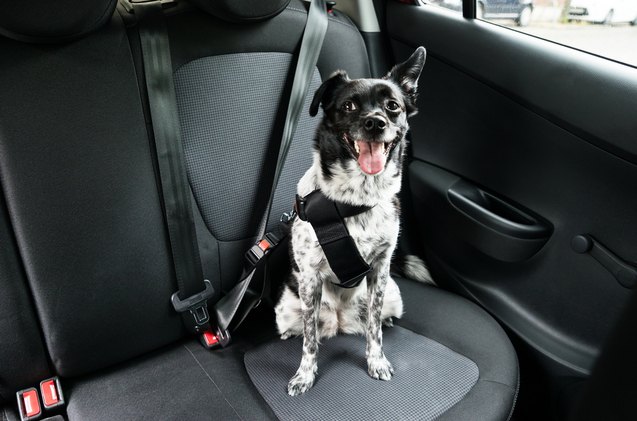Travel Sickness in Dogs – What It Is and How to Treat It

Travel sickness in dogs is not a condition you can miss. When your pooch accompanies you for a car ride, you’re bound to find out soon enough, when they start vomiting all over your car seats. The lucky pawrents probably didn’t have a clue things like these happen, but yes, canines can get car sickness same as we humans do. And it’s not a pretty picture: most pooches will be throwing up throughout the unfortunate voyage. So how can you be sure that your doggo’s car barfing incident is not a part of a bigger problem?
What Is Motion Sickness In Dogs?
It’s very similar to that in humans. If you’ve ever been on a boat or an airplane or even in a car and you’ve got that dizzy, sweaty, ‘I’m about to throw up,’ feeling, that’s pretty much what your dog is experiencing as well.
Vets typically find motion sickness or canine car sickness in younger dogs, though no dog is immune. They believe that is because as in humans, when there is motion sickness, your inner ear is not balanced and your whole body is paying for it. Same goes for your dog–and for younger dogs with less developed inner ears, their balance may be off. (Just think about how funny your little ball of fluff is as he tumbles all over the place. That’s his inner ear working on getting big and strong for balance.)
Experts say that many puppies will ‘outgrow’ motion sickness by the time they’ve had their first birthday cake, but not always.
And that’s the thing. If your adult dog has car sickness, it could be because they’re anxious about being in the car in general. Sometimes they get nauseated because they aren’t getting enough air conditioning (they’ll ram their pupsnouts so far into that air vent you’d think it was glued) or maybe the motion and their vestibular system are out of whack. Maybe they’re not used to car rides and the only ones they have are to the vet, so they have a poor association with cars in general and that anxiety and stress may make them pupchuck or have a pooplosion in the car.
Helping make car rides less stressful and anxious may take some of the symptoms of canine car sickness away, but not always.
You might get that feeling in your stomach and your throat may get dry. The same is likely happening to your dog. Your dog may not show any discoloration, but they do show symptoms they’re not feeling well, and they include:
- pacing in the car
- whining
- stillness/lethargy
- vomitting
- excessing drooling
- diarrhea
Just like in humans, sometimes the only thing you can do is stop and get out for a minute to get some fresh air and calm down. This may be what you need to do for your dog as well, particularly if that ‘gluck-gluck-gluck’ sound alerting you that he’s about to vomit is coming at you. Walking some may give him some stress relief as well, and that may reduce dog motion sickness in the car.
Did your pet start throwing up while you were driving them to the park or the vet? Before you let panic overtake you, make sure to rule out car sickness as a potential reason for your dog’s nausea. Unfortunately, we don’t (yet) speak canine, so you’ll have to rely on non-verbal cues to check if your dog has symptoms of motion sickness. Here are the most common signs that your dog’s vomiting is caused by a car drive:
- Excessive panting
- Unusual licking or smacking of lips
- Whining
- Yawning
- Excessive drooling
- Lethargy
- Uneasiness
Of course, your pet could be having just one or all of the symptoms above when they ride in the car. The most obvious sign of canine car sickness is vomiting, of course, but it’s often preceded by one of the more subtle travel sickness signs. Unless nausea started before you got in the vehicle, it’s highly likely that the driving motion is wreaking havoc on your pup’s digestive system.
Thankfully, while motion sickness is a nuisance both for furry sufferers and their human companions, in most cases it’s an issue that’s easy to solve. The first step is to try common methods of treating travel sickness in dogs, such as:
Pooch should call shotgun. Most dogs who are sick during car rides feel nauseated from looking through the moving landscape from the side windows. In the front seat, your pet is more likely to look in front of them or shift their focus toward you. This is common treatment for humans dealing with carsickness as well. Don’t forget the doggie seatbelt, though!
Carrier inside the car. Some dogs will feel much better if they are inside a pet carrier while in the car. You can throw a blanket over it or leave it as it is- the point is to give your dog a place where they will feel safe and comfy during the ride. A carrier will allow them to feel familiar with something they’re used to and to den for protection. Not to mention, it may help contain vomit should the worst happen.
Anti-nausea drugs. In case all else fails, you can try giving your pet some over-the-counter medications that are designed to alleviate symptoms of canine car sickness. However, you shouldn’t give any drugs to your pooch unless a vet approved it.
If your dog has travel sickness, don’t despair. A few simple steps or modification to your existing routine can help keep nausea at bay- just don’t plan a road trip until you’re sure your four-legged passenger is up for it.

A proud mama to seven dogs and ten cats, Angela spends her days writing for her fellow pet parents and pampering her furballs, all of whom are rescues. When she's not gushing over her adorable cats or playing with her dogs, she can be found curled up with a good fantasy book.
More by Angela Vuckovic























